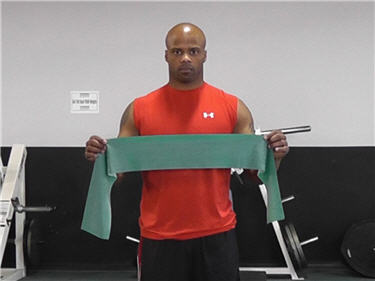Section 1 - Start Here
The Resistance Band
THE RESISTANCE BAND
One of the most popular forms of exercise training today deals with what is known as resistance training. Essentially most forms of training deal with some type of resistance aid (weights, etc.) but the way the term resistance training is used today means to utilize things such as rubber bands or flexible pieces of metal to provide you with a simulated form of weight training. One of the new and more popular types of resistance training aids is what is known as the resistance band or exercise band. See Figure 1.

This is an outstanding product that has a very unique physical property known as a hyperelastic potential. This means that the more you stretch the band the more force you will have to apply. The amount of resistance found within an elastic band is therefore a function of its length when stretched. When used properly, the resistance band is the ideal speed training device.
Here’s a very basic idea of how and why it works: Imagine first that you are performing a biceps curl except that instead of holding a weight, you are holding one end of a resistance band with the other end either attached to the floor or perhaps secured under your foot. Since we are using an isometric contraction, this position with the elbow flexed at about 90 degrees is held for 10-15 seconds without moving it.
While holding this position, imagine the band is already stretched and exerting a significant amount of force back into your biceps muscle. For some, this may be a 40 lb equivalent force, for others, perhaps more. After a few seconds, your biceps muscle will naturally start to weaken. When this happens, your body will begin to recruit more and more motor units to help keep your arm and elbow in this fixed position.
Eventually, and rather quickly if the resistance is high enough, you get to the point where you can no longer hold the band still and maintain the same amount of force efficiently. The muscle has become over-stimulated. This causes your arm to give out or start to shake a little, since the over-stimulated muscle weakens and your coordination dissipates. This is one of the desired states for your muscles to be in to train them for speed and quickness.
These movements in your elbow and arm, however small and in whichever direction, instantaneously alters the amount of force that the resistance bands supply. Unlike weights, which always have the same amount of resistance, the band’s resistance is variable and changes as its length changes. Even small changes in distance, whether greater or less than the starting position, will affect the amount of resistance your muscles exert.
Your muscles constantly perceive these small changes in resistance and alter their typical recruitment pattern of motor units to try and maintain the held position. This new pattern is considerably different than that observed while undergoing a similar exercise with a 40 lb dumbbell, because its resistance is not subject to a change in position.
This is a great benefit to athletes since with each new recruitment pattern of motor units, a muscle’s weakness and lack of coordination on a much deeper level than normally experienced, is instantly exposed, forcing the over-stimulated muscle fibers to immediately get stronger and with more precision than before. Furthermore, the mass of the muscle typically does not significantly increase with this type of training, which, if it did, could potentially offset these gains.
So, whenever you are able to increase a muscle’s strength and coordination without adding any additional body weight, your speed, quickness and athletic performance will automatically increase. This again is just one of the reasons how and why this type of training works.
Imagine now applying this strategy in not only conventional ways, as in the biceps example here, but also in ways and positions you may have never thought of before. When you do this to your muscles, you will immediately expose and then eliminate greater weaknesses in them leading to a vastly improved athletic performance.
Therefore, throughout this entire program, we will be using the resistance band with an isometric training strategy to increase the strength, coordination and contraction rate within specific muscles located in your upper extremities, lower extremities and core - all of which play important roles in the running process, baseball swing and throwing motions.
